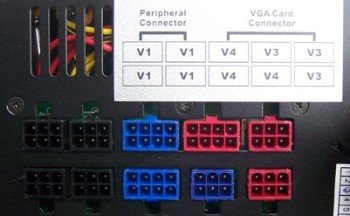Most AC-DC and DC-DC power supplies have internal current protection circuits to protect the power device and the majority of Over Current Protection (OCP) circuits include an automatic recovery feature. Power supplies that have only one OCP circuit are called “single-rail” while the power supplies that have more than one OCP circuits are referred to “multiple-rail”.
The IEC 60950-1 (International Safety Standards for Information Technology Equipment) states that no single output wire in computer power supplies can carry more than 240W. Based upon this standard, the ATX12V specification includes a requirement for an OCP circuit to shut down any rail that pulls more than 240W.
In general, each rail is a set of combined outputs that are tied to a common OCP. At +12V output, 240W translate into a current of 20A (240W/ 12V) on any single wire. However, this relatively low limit would prevent power supply manufacturers from building higher wattage units for computer system with high +12V output. So they came with the idea of breaking down the +12V output into two or more sets of wires, each set of wires with its own OCP. For instance, three sets of wires with an OCP configured at 20A each would triple the maximum allowed power for the +12V output from 240W to 720W.
The +12V power to the motherboard, CPU, SATA, and Molex is usually provided on one rail, with +12V power to PCIe peripherals on subsequent rails. Since the +12V outputs are protected by multiple OCP circuits, there is a need to distribute the +12V loads such that the OCP mechanism doesn’t trip. For example, a particular high-end GPU (Graphic Processing Unit) has a TDP (Thermal Design Power) of 375W. 75W can be drawn from the socket which means that 300W needs to be drawn from the auxiliary PCIe cables of the power supply. The 300W will be provided by 2 x 8-pin auxiliary PCIe connectors rated at 150W each (6-pin PCIe connectors are rated at 75W each). Each of the 8-pin connectors will deliver approximately 12.5A (150W/ 12V). If they were both connected to a single rail which was restricted at 20A, the combined output of 25A would cause the OCP to trip on that rail. Thus, PCIe 8-pin connectors are often on a rail that’s shared only with a PCIe 6-pin connector for a combined 225W, which is under the 240W per the ATX12V specification.
Currently, there are many “single-rail” power supplies with a current rating over 20A on the +12V rail. So how is it possible? The IEC 60950-1 requirement is 240W per wire conductor, so if you get a high current +12V rail and divide it into several wires and make sure no wire will carry more than 20 A, then you meet the restriction.
In summary, the difference between “single-rail” design and “multiple-rail” design is the presence of OCP circuits on the +12V output. Low-end power supplies, however, normally deceive the end-users about the presence of two or more +12V rails. Even though their specification states two +12V rails, but inside the power supply these units only have one OCP circuit and thus these units are in fact “single-rail” products.


